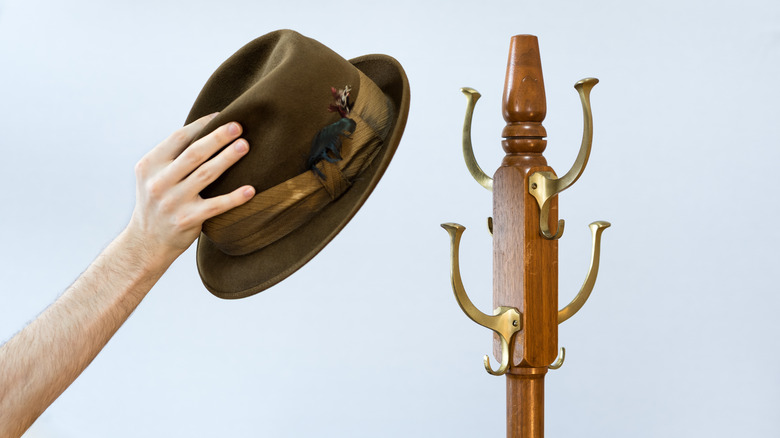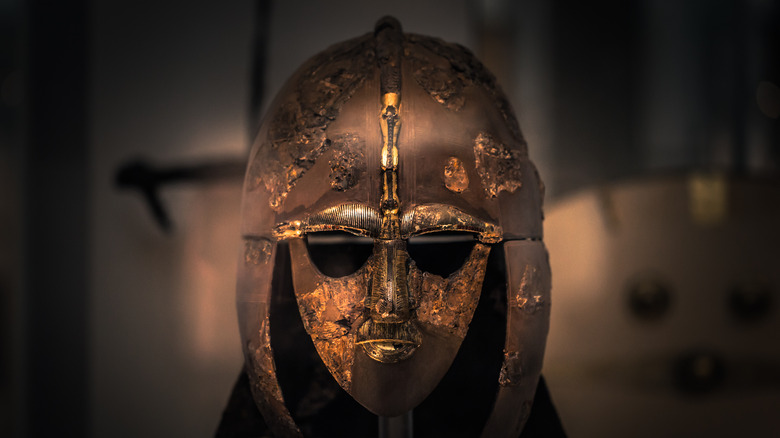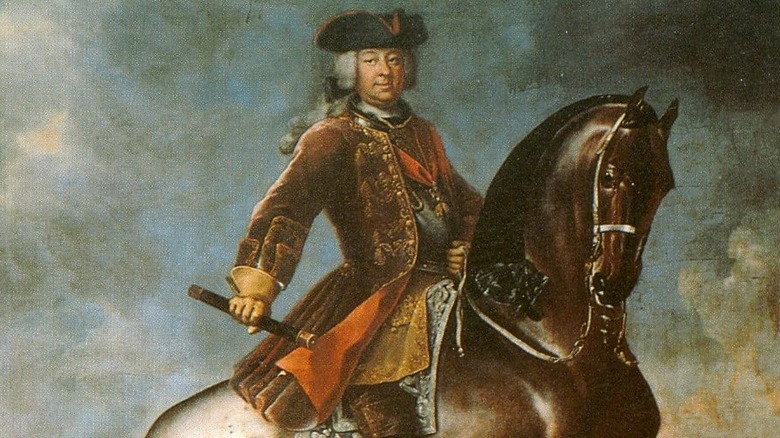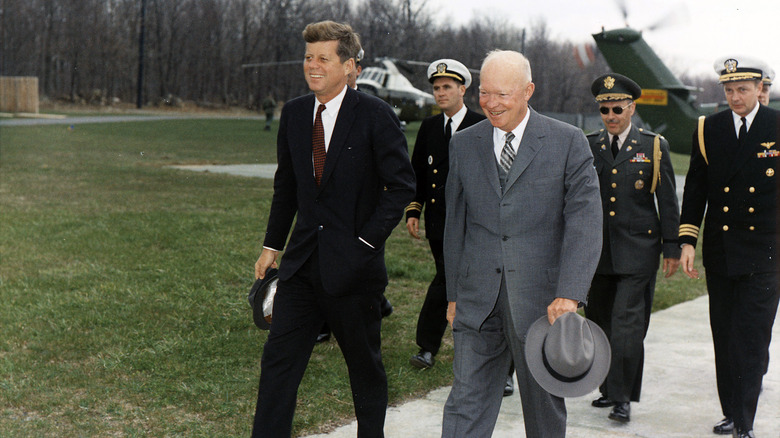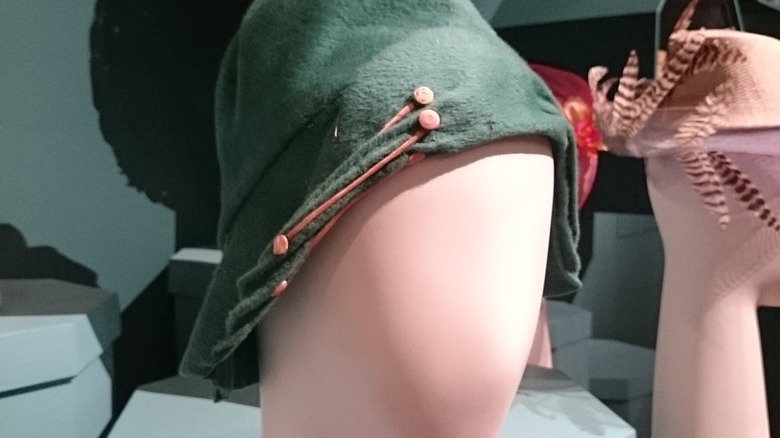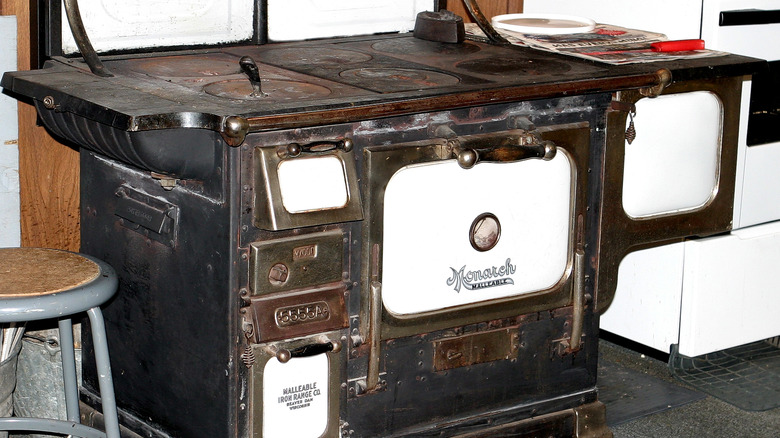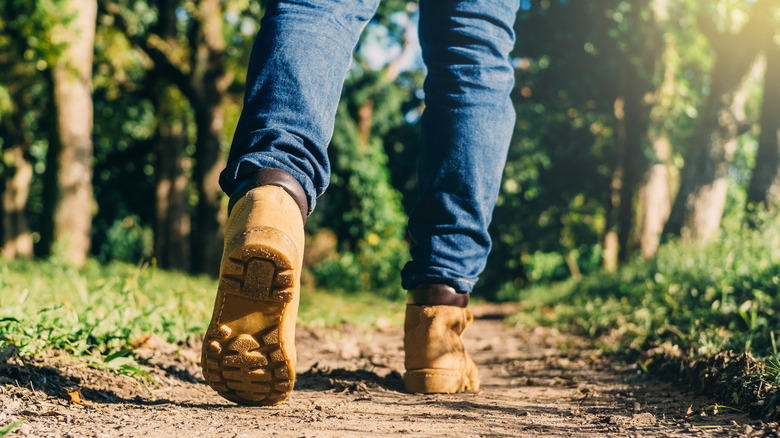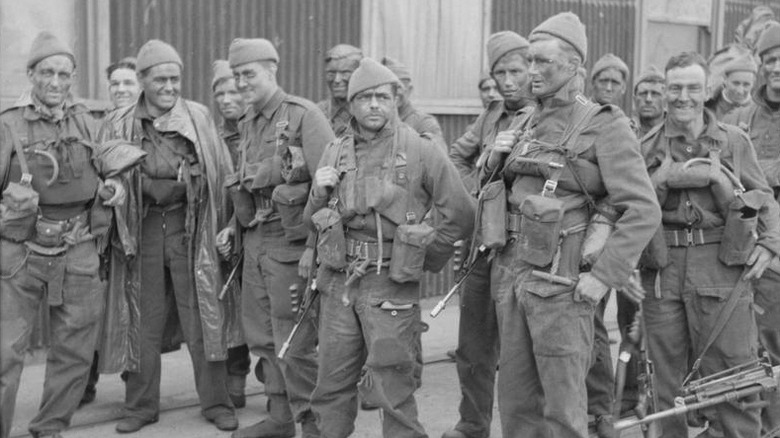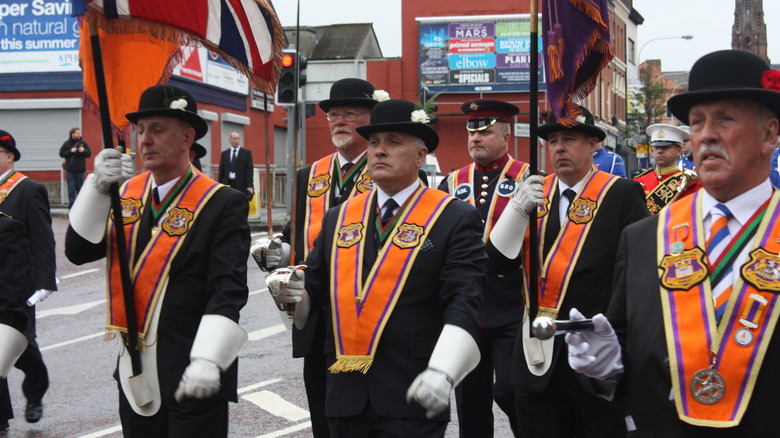Why Men Stopped Wearing Hats
Hoods, capes, and hats used to be ubiquitous in Western culture. By the time the 17th century rolled around, hats were somewhat replaced by or paired with wigs, but quickly came fully back into fashion by the following century. However, in the last several decades men's hats have fallen out of style unless they are for extremely formal occasions, writes Gentleman's Gazette. Nowadays, U.S. presidents wear top hats to their inaugurations, men may wear hats to formal events, and some men wear hats to protect them from the weather, whether that's heat or cold.
However, men used to wear hats to dinner, work, the theater ... just about anywhere you can think of. These days, the only place men in America regularly wear hats is to a baseball game. Why is that? Several reasons actually have to do with changes that occurred rather rapidly across the U.S. during the 20th century, including the quick popularity of cars and the nation's burgeoning highway system. Improvements in medicine and indoor heat over the decades made hats less necessary to keep someone from getting cold or sick as well. Other reasons are more specialized: For example, when military men demobbed after World War II, they were less enamored of headgear after years of wearing it, and so hats went out of fashion among that section of the population. Therefore, let's talk more about why men in the West stopped wearing hats.
In the West, hoods and capes came before the hat
According to BBC, woven hats may date back to as long as 27,000 years ago, made by Stone Age hunter-gatherers. Features that were originally thought to be hairstyles on figurines from the era may in fact be woven hats, indicated on clay fragments discovered in the Czech Republic that showed fairly clear impressions of woven fibers.
According to "A History of Fashion in Headwear," Neolithic, Bronze, and Iron Age Europeans spun wool and sewed leather, and therefore likely had caps and hoods of both materials. But through antiquity and into the Late Middle Ages, most people wore hoods and capes of differing materials. Roman and Celts wore metal helmets in battle that had some similarities between them. Anglo-Saxon women wore veils: one with a hole for the face, while a crown held the material in place, while the other was rectangular, and held together with a metal band. The coverchief was a headcovering that was often embroidered, and was popular for centuries. By the 13th century, several centuries later, women were wearing hoods, capes, and gorgets around the throat, which had been adopted from men's fashions. Men of all classes continued to wear hoods and gorgets throughout this century.
Men laboring outdoors did wear straw or felt hats with brims to shield their eyes from the sun, something that's continued today. But they still weren't a big thing; for that matter, the word "milliner," or a hat maker, didn't evolve until the 16th century (via Hatbox).
Hats were the norm in the 16th through 20th centuries
Fascinators became common in England in the 16th century, though back then, they were more elaborate than they are today, writes Hatbox; the current Catherine, Duchess of Cambridge, often wears modern fascinators. By the 17th century, hats were more outlandish, but the 18th century replaced hats with wigs, even if some people wore them with hats precariously perched on top of the wig (via Hatbox). "An Illustrated History of the Hat: From the Earliest Ages to the Present Time" writes that round hats as seen in the mid-1800s (when the work was published) were first seen in the late 1700s. Then, by the time the 19th century rolled around, hats were firmly in fashion in the Western world, and no man would dream of stepping outside his house without a hat.
Now-famous hats also began to gain popularity. According to Hatbox, the top hat was a symbol of change in the late 1700s, and it was popular with everyone through the next few centuries. The fedora was extremely well worn during the 1900s, as was the homburg hat, made particularly famous by the film "The Godfather." Two straw hats, the Panama and the Milan straw, were popular from the 1800s until the 1960s. Certain hats continue to be popular today, even if not worn as often by men, such as western-style cowboy hats and the flat cap, the latter today seen mainly in Europe. And to add to that, the Kentucky Derby, which began in 1875, also became a major fashion event for hats.
Dwight Eisenhower and America's highways
During Dwight Eisenhower's presidency, he greatly improved America's highway system. According to Federal Highway Administration, he had participated in a military vehicle convoy in 1919 that spanned the country for two whole months, and it quickly became clear to him (and many others) that the U.S. desperately needed better roads. Eisenhower's original plans were mainly limited to two-lane highways, but after witnessing Germany's superhighway expansion in the 1930s, his plans shifted. By the 1950s, Eisenhower was president and could make his plans a reality.
The Interstate System began during the 1950s and was nowhere near finished by the time Eisenhower left office. Even so, as time went on, many more people began to get around using cars, which generally didn't have enough room for hats, writes NPR. Essentially, for those in the driver's seat, there simply wasn't enough space from the top of the head to the roof of the car for a hat, unless it was one that could be crushed safely, such as a fedora.
Gentleman's Gazette writes that early cars did have more headroom or open roofs, but as time went on, roof heights got lower and lower, to the point where hats could not comfortably be worn while in a car.
John F. Kennedy and the top hat at his inauguration
Over the course of a few U.S. presidential inaugurations (namely Franklin Delano Roosevelt and Harry S. Truman), it had become traditional for the president to wear a top hat. However, Dwight Eisenhower broke tradition by wearing a homburg. People encouraged John F. Kennedy to bring back the top hat tradition, and he eventually agreed. Some were dismayed, feeling that the style was too grand, while others were pleased that the event was getting the grandeur it was due. The Baltimore Sun's columnist wrote at the time: "It is in its ceremonial aspect that the top hat is without peer," (via Baltimore Sun). When John F. Kennedy appeared at his inauguration, he was wearing his top hat, writes the Baltimore Sun, though he took it off often to wave to the crowd, even on such a frigid January morning.
Did JFK's refusal to wear the hat while addressing the crowd at his inauguration single-handedly kill the popularity of the top hat? Primer Magazine writes that forgoing top hats began as a trend among university students several decades before Kennedy's inauguration, and Kennedy wearing the hat at his inauguration was actually meant to bring the top hat back into fashion among American men. Unfortunately, the attempt failed, and the top hat was brought down as a known accessory in American life.
Famous figures influenced hat fashions
A person or group often has to declare a thing fashionable before everyone else catches on. In most societies, those people tend to be the rich and powerful. During the 1700s, Napoleon Bonaparte embellished the status of the bicorne hat. Once the 1800s rolled around, Abraham Lincoln added to the popularity of the top hat. And so top hats, which once got John Hetherington arrested and fined in 1797, instead began to work their way into society as a trend (via Hatbox).
Thomas Gainsborough painted portraits of women wearing wide hats that framed the face. These hats could be very elaborate, and often included feathers and ribbons, writes Barnabys Magazine; they eventually became known as Gainsborough hats. In the 1920s, cloche hats became well-known for being worn by celebrities and other noblewomen. Homburgs, fedoras, and bowlers also all became well-known and fashionable in the 1900s, and were all worn by men powerful at the time, such as Winston Churchill and Dwight Eisenhower, who influenced fashion simply by virtue of being who they were.
The Italian company Borsalino also began to indirectly influence hat fashion because they made a few hats for very famous actors at the time, such as Humphrey Bogart, who wore one of their fedoras in the 1942 film "Casablanca." The actor Charlie Chaplin greatly popularized the bowler hat in his films, turning it into a popular and well-known accessory (via Barnabys Magazine).
More even heating systems
Modern heating systems also provided more heat than previously in history. Therefore, men didn't need to wear hats in their own homes to keep warm, writes Gentleman's Gazette. Similarly, unless one is in a terribly cold climate, gloves and shawls are less necessary, especially when only moving from the heated office to the soon-to-be-heated car. More men have begun to work indoor office jobs in recent decades as well, meaning that they aren't working in the outdoor heat and neither are they working in a cold indoor environment, since many offices are now heated.
Shipton's Heating and Cooling writes that up until the 19th century, the main source of heat in a private home came from either the stove or hearth. Since stoves were generally centered in the home, that also meant that other rooms, such as bedrooms, could be very cold on winter mornings. Anyone remember this from "Little House on the Prairie"? There is (or used to be, anyway) a reason for those flannel pajamas family members bought for holidays! As central heating moved onto steam and centralized heating that reached the entire house in the late 19th century — and then warm air systems in the 20th century — people had several more options to keep themselves warm. They didn't have to rely so heavily on clothing, and hats in particular.
Layered, sturdier clothing
Better, sturdier clothing throughout the decades also assisted with keeping the body warm. Therefore, men didn't need to lean so heavily on hats specifically to keep warm. Though it is true that keeping one's head and feet warm go a long way towards keeping the body as a whole warm, better clothing certainly helped. In the rain, modern raincoats help keep people dry, and while hats helped in the past, they aren't as necessary now. If someone is only out of doors for a few seconds to go from home to their car (as opposed to a long walk to the bus stop, as was the norm in the early 20th century), a hat won't necessarily help with the weather, writes Gentleman's Gazette.
According to The Guardian, layering clothing more strategically specifically helped keep people warm so they could rely less on hats. If someone makes a point of wearing heavy socks and solid close-toed shoes, as well as heavy pants and shirts, then they are fairly protected from the weather already. Though a hat would help, it wouldn't be nearly as useful as it once was, when clothing was less sturdy or people couldn't afford as much decent quality clothing. The types of hats people think of when they think of the past were also most definitely not anyone's idea of a heat-retaining piece of headwear; a bowler hat is specifically made to sit very close to the head and doesn't have much of a brim.
Men demobilizing from the military after World War II
With so many men demobilizing from the military after World War II, many swore off hats after wearing military headgear for so many years. As a result, hats were less common among men of a certain age after the second half of the 1940s. According to the Hat Research Foundation, writes Esquire Middle East, in 1947, 19% of men who didn't wear hats put "because I had to in the army" as their reasoning. After needing to wear military helmets for such a long time for protection, it must have been freeing to walk around bareheaded.
The Guardian also noted that many men of that generation may have been forced to wear hats or caps as schoolboys, which also might have contributed to the decision to forego hats after the war. Once enough men went without hats that it could be a trend, it was less strange to others, and so hats became less common among that generation and group of the population. It must have been a relief, to realize that there was little to no risk of social ostracization because so many men were in the same boat after the length of the war.
Societal changes in class signifiers
Different hats implied different social statuses among people in certain regions or countries. Each country handled the class signifiers of hats slightly differently. With social classes changing rapidly in the 19th and 20th centuries, hats did begin to fade out as a major class signifier. For example, the English middle classes borrowed the bowler hat from the upper classes in the 19th century in an attempt to cross class lines, while the lower classes often wore flat caps, according to "The Social Meanings of Hats and T-Shirts"; the bowler was eventually claimed by the bourgeoisie.
In the U.S., everyone wore hats in the 1800s, and people attempted to blur class boundaries less often than in England, usually only doing this outside the home. For example, a photo taken of workers on their own time shows most of them in bowler hats, while a photo at their place of work, the San Fransisco Stove Works, shows most of the workers instead wearing flat caps.
Therefore, particular class statuses, regions, and cities lent themselves to a particular hat style. As time went on, with dress becoming less formal and people changing into different types of jobs, hats faded away as a class indicator and formal icon of a particular area or status. Now, the rich and famous often dress just like everyone else, with little to pick them out among the crowds. Basically, the well-known look just like the rest of us.
The invention and widespread use of antibiotics
With the advent of antibiotics, treating a cold or any other minor illness became less of a problem. Before antibiotics, most children would die from bacterial meningitis. Tuberculosis and pneumonia, which could develop from a simple cold, could also be fatal illnesses, according to Healthy Children. When penicilin was discovered in the 1940s and saved lives (more so from illnesses but also infections from injuries) during World War II, it was hailed as a miracle drug. So many illnesses suddenly weren't death sentences, and therefore, people didn't need to rely on hats so much to keep warm and stave off sickness quite as much.
Warm wool hats such as beanies, of course, do continue to keep people warm in cold times, but they aren't nearly so necessary now; in the past, the idiom "you'll catch your death of cold" was quite literal, and it wasn't uncommon to catch a cold from being in the rain. Now, colds are much more easily treated by antibiotics, writes Healthy Children, and getting a cold or similar illness isn't a death sentence, merely an inconvenience. The Guardian writes that colds could develop into pneumonia, and it was known that keeping your head warm was one of the best things you could do to stave off illness, especially during times when indoor buildings were either not heated at all or not heated well. Therefore, hats were vital in the past. Now, not quite so much.
